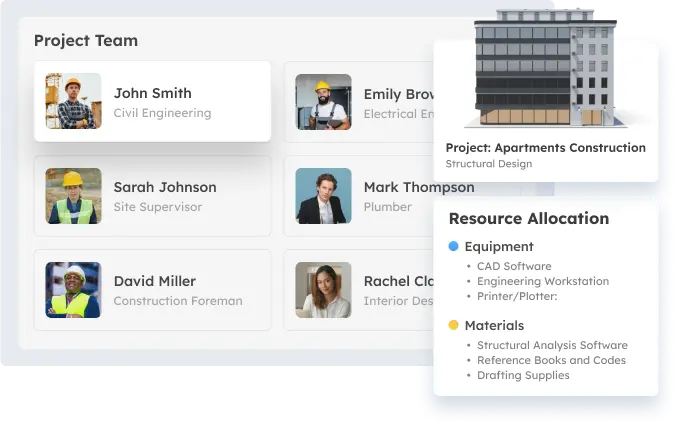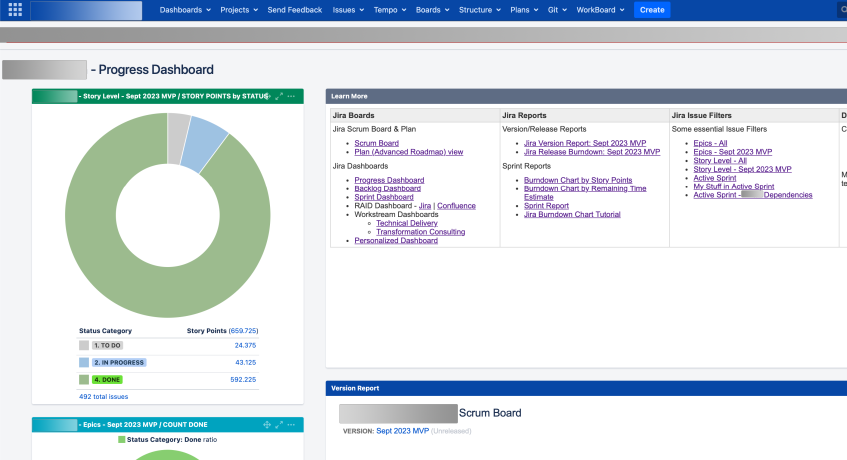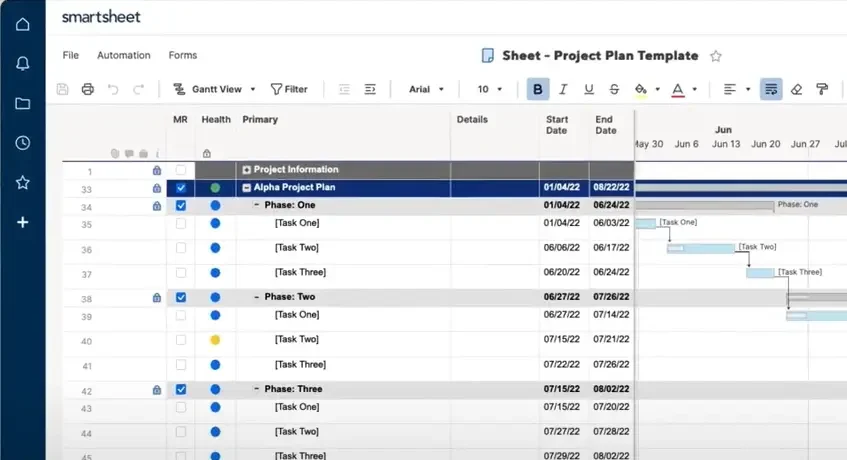In Singapore’s fast-paced business world, staying organized is everything. Projects have numerous moving parts, including deadlines and team members, and keeping track can be a significant challenge. This is where project management software comes into play, providing a structured approach to handling complexity.
In Singapore’s fast-paced business world, staying organized is essential. Complexity may be managed more effectively with project management software. Similarly, GovTech‘s Open Digital Platform (ODP) brings together systems and data to improve collaboration and efficiency throughout Singapore’s urban landscape.
In this article, we will examine the top 12 project management software choices in Singapore, including ScaleOcean, Zoho, Wrike, and Monday.com, among others. Selecting the best solution for your company is crucial because each one has special features catered to various team requirements and project kinds.
- Project management software is a tool that organizes, executes, and tracks projects, ensuring efficiency and order.
- Best project management software includes software like ScaleOcean, Zoho, Wrike, Monday.com, Jira, ClickUp, and more.
- Choosing the right project management software requires assessing your needs, involving your team, and considering the long-term return on investment.
- ScaleOcean’s project management software solves these challenges by offering a powerful, all-in-one solution designed to support your business’s growth.

What is Project Management Software?
Project management software is designed to help teams organize, execute, and track projects from start to finish. It serves as a consolidated platform for organizing information and operations, enabling efficiency and order in dynamic work situations.
These tools range from basic to-do lists to major business systems like those utilized in Singapore. With AI integration, these platforms can expedite procedures, improve team collaboration, and provide greater project visibility, ultimately boosting project outcomes.
Why Your Business in Singapore Needs Project Management Software

Efficiency is crucial for business growth in Singapore’s competitive market. A strong project management system helps stay organized and accelerate development. According to IRAS, the RIC introduced in Budget 2024 aims to enhance Singapore’s attractiveness for investments, improving ROI.
Operations are streamlined by the correct software, which enhances resource allocation and boosts profitability. Selecting the appropriate tool can determine whether a project is successful or delayed. The main advantages of utilizing project management software are listed below:
1. Improved Planning & Scheduling
Good project management always kicks off with a really solid plan and a schedule that’s actually realistic. The right software provides all the tools you need to map out tasks, set clear deadlines, and spot dependencies between different parts of a project.
Tools like Gantt charts and integrated calendars let you visually trace the project’s journey from its start to the very end. This makes it significantly easier to catch potential bottlenecks well before they turn into huge, costly problems.
2. Enhanced Team Collaboration
Collaboration is essential, but it can get complicated when teams are physically separated or focusing on various elements of a project. A project management system centralizes everything, forming a hub where team members can easily communicate and share files, particularly in hybrid teams.
Team members can use these features to comment directly on tasks, tag colleagues for updates, and instantly identify who is responsible for each task. This transparency fosters a strong sense of shared ownership and keeps everyone informed, resulting in improved team cohesiveness across varied work contexts.
3. Centralized Task and Resource Management
Honestly, knowing exactly who is doing what, and by when, is truly fundamental for the success of any project. These platforms empower managers to assign tasks clearly, set priorities effectively, and monitor progress as it happens, in real-time. This kind of oversight ensures that nothing falls through the cracks.
Beyond tasks, it’s also about managing your resources, which includes people’s valuable time and available equipment, much more effectively. You can easily spot who might be overworked and who actually has the capacity to take on additional responsibilities. This generally leads to a much better distribution of workload across the team.
4. Better Budget and Time Tracking
Keeping projects on budget and delivering them on time are probably two of the toughest challenges anyone faces in project management. Thankfully, a lot of today’s software solutions come equipped with really robust built-in time tracking and budgeting features. This capability ensures financial clarity from the start.
This real-time data is incredibly valuable for maintaining the financial health of any project, allowing for proactive management. You’re able to quickly compare what’s actually been spent against your original planned budget and then make necessary adjustments on the fly, which is a practical choice in most scenarios.
5. Data-Driven Reporting & Analytics
If you want to make genuinely good decisions, you absolutely need good data to back them up. Project management software does an excellent job of gathering a wealth of information about your team’s performance and the overall project progress. Then, it cleverly transforms all that raw data into accessible, easy-to-understand reports.
These kinds of insights are fantastic for spotting trends, measuring your key performance indicators (KPIs), and really understanding exactly where you can make improvements. You certainly won’t be relying on guesswork anymore. Instead, you’ll be making strategic, data-backed decisions that truly move the needle.
The 12 Best Project Management Software in Singapore
Given the abundance of project management software alternatives in Singapore, selecting the correct one might be difficult. Each solution has distinct advantages, tailored to particular team demands and project kinds. The optimal fit is determined by your specific business requirements.
We analyzed the project management landscape and developed a list of the top candidates. This list should serve as a good starting point for your research, taking into account elements like team size, workflow, and budget while evaluating the tools.
1. ScaleOcean’s Project Management Software

ScaleOcean’s project management software is one of those tools built with businesses in mind that really need something powerful, yet also straightforward and intuitive to use. It’s pretty good at centralizing all your communication and simplifying complex workflows, which, let’s be honest, is a frequent headache for many teams.
Now, where ScaleOcean really shows its strength is in giving you a super clear, high-level overview, while still letting teams dive deep into the tiniest details when needed. With access to ScaleOcean’s CTC grant, businesses can streamline operations and maximize project outcomes effectively.
Key Features:
- Task & Resource Management: Efficiently track, manage, and allocate tasks and resources for seamless project completion and optimal utilization.
- Collaboration & Communication: Enhance team collaboration with integrated communication tools, real-time updates, and shared workspaces for project alignment.
- Planning & Visualization: Utilize Gantt charts, Kanban boards, and timelines for clear project planning, resource allocation, and forecasting.
- Reporting & Analytics: Gain real-time insights with customizable reports and dashboards for data-driven decision-making and project monitoring.
- Integrations & Automation: Automate workflows and integrate with key tools to streamline processes and improve efficiency across departments.
| Pros | Cons |
|---|---|
|
|
2. Zoho Projects Management
One of the most popular tools in Zoho‘s larger array of business apps is Zoho Projects. For teams seeking a one-stop shop, it provides a variety of tools to aid in project planning, monitoring, and collaboration.
Its adaptability, which makes it appropriate for both smaller teams and larger organizations, is one of its advantages. Integrating Zoho Projects into your workflow might be simple and easy if your business already employs other Zoho products.
Key Features:
- Project planning and tracking tools
- Collaboration features for teams
- Integration with other Zoho products
- Task management and reporting
- Customizable workflows
| Pros | Cons |
|---|---|
|
|
3. Wrike Project Management System

Wrike is a flexible tool that works well for marketing and creative teams. It provides configurable dashboards, processes, and request forms, providing customers with complete control over their settings. This versatility enables it to suit a variety of operational requirements across teams.
One of its standout features is the proofing and approval tools, which are especially valuable for teams that manage a large number of creative materials. Wrike is also designed for scalability, making it an excellent choice for firms that plan to grow over time.
Key Features:
- Customizable dashboards
- Workflow automation for efficiency
- Proofing and approval tools for creative teams
- Scalable design for business growth
- Real-time collaboration tools
| Pros | Cons |
|---|---|
|
|
4. Monday.com
Monday.com is well-known for its visually appealing design, which simplifies project tracking. The platform is highly flexible, with a “board” architecture that may be configured for a variety of workflows. Users frequently enjoy this versatility.
It is an effective tool for teams that require extensive control over how they arrange and manage their work. Monday.com demonstrates adaptability across a wide number of use cases for various departments, whether managing sales pipelines or simple content calendars.
Key Features:
- Highly customizable board system
- Project and task tracking
- Workflow automation
- Collaboration tools for team communication
- Visual project tracking and progress updates
| Pros | Cons |
|---|---|
|
|
5. Jira Project Management Software Singapore

Jira, invented by Atlassian, is a well-known software for software development teams. It is based on agile approaches like Scrum and Kanban, making it ideal for such environments. Jira’s strengths include its interaction with other developer tools and its robust bug-tracking capabilities.
Although Jira can be used for a variety of project types, it is most effective in technical environments. However, for teams that are not focused on technology, the learning curve can be steep at first, needing time to become acquainted with its features.
Key Features:
- Built for agile methodologies (Scrum and Kanban)
- Integration with other developer tools
- Comprehensive bug-tracking capabilities
- Customizable workflows for different projects
- Real-time collaboration tools
| Pros | Cons |
|---|---|
|
|
6. ClickUp Project Management Platform
ClickUp promotes itself as the “one app to replace them all,” and it attempts to achieve this goal. The platform contains a variety of capabilities, including tasks, documents, goals, and even whiteboards, with the purpose of serving as a holistic team productivity tool.
This all-encompassing approach can be viewed as both advantageous and, at times, challenging. While it provides a variety of capabilities, some users may find the number of possibilities overwhelming, particularly when initially using the platform.
Key Features:
- Task management and assignment tools
- Document sharing and collaboration
- Goal tracking for team progress
- Whiteboard functionality for brainstorming
- Customizable workflows for various needs
| Pros | Cons |
|---|---|
|
|
7. Smartsheet Project Management

Smartsheet distinguishes itself from the competition by taking a spreadsheet-inspired approach to project management. If you’re used to Excel, this interface will feel familiar, but with additional capabilities that will help new users adapt fast, making it an effective project management technique.
It’s useful for task tracking, process management, and automated workflows. If your company relies significantly on spreadsheets, Smartsheet can be a useful upgrade that adds new functionality and improves operational efficiency.
Key Features:
- Spreadsheet-like interface for ease of use
- Task and process tracking tools
- Workflow automation for efficiency
- Collaboration and sharing tools for teams
- Real-time updates and notifications
| Pros | Cons |
|---|---|
|
|
8. Basecamp Project Management System
Basecamp has a long history in project management, with a focus on simplicity. It’s intended to serve as a unified platform for teams to communicate and organize their efforts. The utility eliminates superfluous functionality, providing users with a clean, basic experience.
It’s especially beneficial for remote teams and organizing client work, as it gives each project its own space. Basecamp’s concept is based on encouraging straightforward communication and removing needless complexity in team collaboration to make work more effective.
Key Features:
- Project organization and task management tools
- Team communication tools (chat, messaging)
- File sharing and document collaboration
- To-do lists for task management
- Calendar for scheduling and deadlines
| Pros | Cons |
|---|---|
|
|
9. Trello Project Management Software
Trello is well-known for its simple, user-friendly Kanban board interface, which facilitates task organization. Users generate task cards and slide them across columns to reflect different stages of the procedure. This visual approach makes it simple to get started, especially for beginners.
While Trello lacks some of the more technical capabilities found in other apps, its ease of use makes it perfect for small teams or individuals. It’s especially handy for organizing simple projects and tracking progress in a clear, visual way.
Key Features:
- Kanban board interface for task management
- Task card creation and movement between columns
- Visual workflow tracking
- Customizable boards for various use cases
- Simple drag-and-drop interface
| Pros | Cons |
|---|---|
|
|
10. Asana Project System
Asana is a well-known application for helping teams coordinate a wide range of work, from daily tasks to larger strategic projects. It has many views, such as lists, boards, and timelines, making it suitable for various working styles and team demands.
The platform is simple to use and scales efficiently, accommodating both small teams and huge companies. Asana is a reliable project management system, providing flexibility and capability for teams of all sizes and demands.
Key Features:
- Multiple view options (lists, boards, timelines)
- Task management and assignment features
- Progress tracking and reporting tools
- Integration with various third-party tools
- Team communication tools
| Pros | Cons |
|---|---|
|
|
11. Quickbase Project Software
Quickbase is a low-code platform that allows enterprises to create customized applications for project management and other operations. Rather than providing a pre-made solution, it gives a toolbox that allows you to build the applications your team needs.
This platform is often best suited for larger businesses with specialized, sophisticated requirements that ordinary software may not fully meet. However, proper installation demands a certain level of technical competence, which should be considered.
Key Features:
- Low-code application development tools
- Customizable workflows for different teams
- Project and task management features
- Integration with other platforms
- Automation tools for repetitive tasks
| Pros | Cons |
|---|---|
|
|
12. Copper Project Management Software
Copper acts as a CRM that is designed to interface seamlessly with Google Workspace, providing great convenience. While its major function is customer relationship management, it also has project management capabilities, making it appropriate for client-related initiatives.
If your workflow includes Gmail and Google Calendar, Copper provides a smooth experience. It consolidates client data and project activities into a single location, streamlining operations by keeping everything organized and accessible.
Key Features:
- CRM with project management capabilities
- Seamless integration with Google Workspace
- Email and calendar synchronization
- Task management and collaboration tools
- Real-time updates and notifications
| Pros | Cons |
|---|---|
|
|
Key Features to Look For in Project Management Software
When you’re trying to compare different project management software options, it’s easy to get overwhelmed by all the features available. It’s really important to hone in on the core functionalities that are actually going to make a difference for your team’s productivity, since not every single bell and whistle is necessary for every business out there.
Consider your everyday workflow, the actual challenges you’re looking to solve, and what it is you want to improve. This helps pinpoint the must-have features for your particular situation. So, let’s go through some of the most crucial ones you should probably be looking for, you know, for better project management in Singapore and beyond.
1. Task Management
Project management is really about task management, and the ideal software should make it easier to create, assign, and track tasks throughout their lifecycle. Due dates, prioritizing tasks, and breaking them down into subtasks are all important considerations.
A good task management system promotes transparency and accountability. Kanban boards, Gantt charts, and lists are excellent ways to depict workflows, ensuring that every team member understands what they’re working on and when it’s due, making them a crucial component of any project management tool.
2. Collaboration Tools
Because a project is always, and I mean always, a team effort, your software absolutely has to make communication easier for everyone involved. Essential features here are real-time comments, sharing files, and those team dashboards, which help keep everyone connected and informed, you see.
The main idea, really, is to have one single source of truth for all project-related chats and updates. This cuts down on all those scattered emails and endless meetings. Having truly effective collaboration features is often what elevates a good project management tool into a truly great one.
3. Resource Management
Properly managing your team’s workload is super critical, you know, to avoid burnout and to make sure those deadlines are actually met. Resource management features are pretty key because they give you a clear view of who’s doing what, letting you see team capacity and then allocate tasks much more effectively.
For businesses, especially in Singapore, where having good talent is such a key asset, this is incredibly important. You really do want to make sure your team’s time is being utilized efficiently, and honestly, good resource planning can totally determine a project’s success or failure.
4. Time Tracking
It’s crucial to understand just where time is going, really, both for improving efficiency and for keeping budgets in check. Time tracking features let your team log their hours against specific tasks or entire projects, and this kind of data, well, it’s just incredibly valuable in the long run.
This information helps a lot with accurate client billing, for estimating future projects, and also for spotting any productivity bottlenecks that might come up. Even if it feels like a little extra step sometimes, the deep insights you get from accurate time tracking are definitely worth the effort.
5. Reporting and Dashboards
It’s a well-known fact that if you can’t measure something, you really can’t improve it either. Good project management software will offer customizable reports and visual dashboards, letting you easily track key metrics and get a high-level view of how healthy a project is at a glance.
These tools are absolutely vital for decision-makers who need to grasp performance without having to dig through endless task lists. Finding software that provides clear, actionable reporting is really key to guiding your overall strategy.
6. Automation and Integrations
Those repetitive administrative tasks, they really can just drain your team’s time and energy, you know. So, looking for project management software with solid automation capabilities that can handle things like sending reminders or updating task statuses is smart, because it frees up your team to focus on the more important stuff.
On top of that, the software really should integrate well with all the other tools you’re already using, such as your email, cloud storage, and calendars, too. Having strong integration capabilities is what makes sure the tool fits smoothly into your current workflow and ecosystem, with minimal fuss.
How to Choose the Right Project Management Software
Choosing the proper project management software is an important decision. It’s a significant time and financial investment, so doing it properly is critical. What works for one company may not be suitable for another, so careful analysis is required.
It is critical to obtain feedback from those who will be using the product daily. A more systematic approach will assist you in identifying a solution that fulfills your requirements. Finally, it’s about selecting the best fit for your company. Here are some important measures to follow:
1. Assess Your Needs
Before you dive into looking at any specific product, it’s crucial to really sit down and figure out what your team actually needs. What are the major headaches in your current setup, and what problems are you truly hoping to solve with new software? This initial understanding of your core requirements is key to making a smart choice.
A good way to start is by listing out your absolute must-have features versus those that would just be nice to have. Think of this as your personal scorecard when you begin comparing different options. Really, a clear assessment of your needs is the absolute most critical first step, and it sets the stage for everything else.
2. Consider Your Team
Honestly, the most amazing software out there means nothing if your team simply won’t adopt it. You really need to think about your employees’ current technical skills and how they typically like to work. Is this new tool going to feel intuitive and easy for them to pick up quickly?
Make sure to get your team involved in the selection process, maybe let them test out a few of the top choices. Securing their buy-in from the beginning tends to make the whole adoption process so much smoother later on. Ultimately, the chosen tool absolutely needs to be a good fit for your team’s culture to succeed.
3. Evaluate Integrations
Your new project management software mustn’t just sit in its own silo. It needs to play nicely with all the other tools your business uses daily. Take a moment to list out your essential software, things like your email, cloud storage, and communication apps. Check if potential PM tools integrate well with your existing systems.
When systems are well-integrated, it really does create a much more efficient and connected workflow for everyone. This stops you from constantly jumping between different applications, which is a huge time-saver. Seriously, don’t underestimate the importance of smooth software integrations.
4. Look at Cost and ROI
Naturally, the budget is always going to be a significant part of the conversation. Most project management software is priced per user, per month, so calculate the total cost for your team and compare it to your budget. This gives you a clear picture of the immediate financial commitment.
However, try not to get too fixated just on the initial price tag. It’s smart to think about the potential return on investment, or ROI. A tool that actually manages to save your team hours of work every single week could easily justify a higher upfront cost. Consider the long-term value and efficiency gains the right software can provide.
Conclusion
Switching to dedicated project management software is a critical step for Singapore firms seeking to grow and compete. It’s more than just task organization. It’s about creating a more efficient, transparent, and collaborative work environment, which improves overall results.
The advantages of greater planning, teamwork, and data-driven insights are evident. ScaleOcean’s project management software is an ideal alternative for firms seeking efficiency and optimized operations. You can also explore its full potential through a free demo, making it a smart investment in your company’s growth.
FAQ:
1. What are the 5 C’s in project management?
– Clear objectives: Setting specific, measurable goals for the project.
– Comprehensive planning: Creating a thorough plan covering all aspects of the project.
– Collaboration: Encouraging effective teamwork and open communication among all parties.
– Control: Continuously tracking project progress and making necessary adjustments.
– Commitment: Ensuring full dedication from all team members involved.
2. What are the 4 P’s of project management?
– Project: The specific tasks or objectives to be accomplished.
– People: The individuals involved in executing the project.
– Process: The methods or procedures used to complete the project.
– Performance: Assessing and tracking the success of the project.
3. What are the 5 M’s of project management?
– Man: The team members working on the project.
– Machine: The equipment, tools, and technology used in the project.
– Materials: The raw resources required for the project.
– Method: The approach and techniques followed during the project.
– Money: The financial resources allocated for the project.
4. What is the 4 D model of project management?
– Define: Outline the project’s objectives, scope, and goals.
– Design: Plan the approach, resources, and strategy for the project.
– Develop: Execute the plan and begin creating the project’s deliverables.
– Deliver: Finalize and hand over the completed project, ensuring all objectives are met.







 PTE LTD..png)
.png)

.png)








.png)
.png)
















